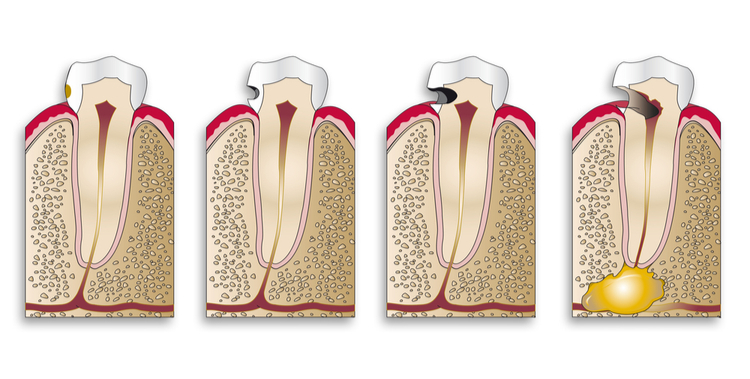What to do when a cavity has spread to the pulp?
When a cavity appears, you will need help from your dentist to stop its growth and protect your teeth from further damage. At an early stage, your dentist can easily deal with the cavity on your tooth enamel. However, if you keep putting off treatment, the cavity will get deep into the tooth pulp, resulting in many serious problems.
Advanced cavities can cause tooth sensitivity, pain, discomfort, and even require a tooth extraction in severe cases. Therefore, if you suspect that the cavity has gotten to your tooth pulp, visit The East Rose Dental (Old Rose Dental Clinic) as soon as possible for timely treatment.
What is tooth cavity?
Tooth cavity is a progressive process where bacteria build up in your mouth and create an acid that weakens the tooth surface. This acid causes small holes in your teeth. These holes enable bacteria to further attack the inner parts, resulting in more and more severe infections.
In the early stages of tooth cavities, you won’t feel much pain, and hence, won’t notice that your teeth are being attacked by bacteria. Regular dental checkups can help you detect tooth cavities early on and prevent them from developing.
Causes of tooth cavities
Common factors that result in tooth cavities include a diet high in sugar and carbohydrates (sodas and bottled drinks without fluoride) and not brushing as well as using dental floss regularly. Some medications used to treat certain conditions can also increase the likelihood of cavities.
Cavities usually begin from the tooth enamel, especially from the areas that are more prone to plaque build-ups such as the notches on the tooth surface and the gaps between teeth. This plaque is the result of food debris left in the mouth for a long time. It enables bacteria to grow and produces acids weakening the tooth enamel.
Stages of tooth cavities
First off, let’s learn about the anatomy of a tooth to understand how each stage of cavities affect it.
Each tooth has 3 layers from outside in, including the enamel, dentin, and pulp.
- The enamel: The outermost layer of a tooth that can be seen by the naked eye. It is also the hardest layer that serves to protect the inner tooth structures.
- The dentin: A yellow layer beneath the enamel. The dentin – with many tiny tubes inside - is much softer and more porous than the enamel
- The pulp: The innermost layer of a tooth containing many blood vessels and nerves that provide nutrition for tooth growth and sensory function.

Initial stage: Enamel damage
The enamel is considered the hardest part of the human body. Although it is not easy to damage it, bacteria can attack and damage the enamel in certain conditions.
At first, there will be small brown or white spots appearing on the enamel. These spots will grow into larger holes. Normally, the damage at the initial stage can’t be detected using X-rays. However, an experienced, well-trained dentist can easily recognize that a cavity is developing.
Stage 2: Enamel decay
There will be larger holes on the tooth surface when the enamel is severely damaged. X-rays will help show the extent of this damage. The more the cavities spread to the inside of the tooth, the more intensive toothache gets.
Stage 3: Dentin decay
Through the holes on the enamel, the bacteria will begin to attack the dentin if the cavity is left untreated. This will deteriorate gradually because the porous dentin will allow the bacteria to grow faster. Therefore, treatment is required as soon as possible.
At this time, you may experience mild tooth pain. Your tooth will also become more sensitive to hot or cold foods and drinks.
Stage 4: Pulp decay
When the bacteria have reached the soft tissue inside your teeth, this is now called pulpitis and requires immediate treatment. In this stage, you will experience significant pain and your tooth will become much more sensitive.
Stage 5: Abscess formation
If the infection is left untreated, an abscess can form at the end of the tooth root. This abscess won’t resolve on its own and requires to be treated by a dentist. In more severe cases, bacteria can spread to surrounding areas such as the jaw bone, affecting the ear and neck on one side. In some cases, bacteria can reach the brain and cause unpredictable complications. At this time, you will experience extreme pain with excessively high sensitivity in the tooth and gums. You may not be able to sleep as the pain worsens while lying down. Your mouth can also have an unpleasant taste.
Signs that a cavity has spread to the pulp
Many people neglect their bouts of pain and don’t visit their dentist regularly. They only seek treatment when the cavities are in the late stages. If a cavity has reached the pulp, there will be symptoms of pain and discomfort that cause trouble in everyday activities.
Visit The East Rose Dental (Old Rose Dental Clinic) right away if you have the following symptoms:
- Prolonged pain bouts lasting for 10-15 minutes, depending on the severity of cavities
- Tooth pain together with headache and sensitivity in the surrounding teeth
- Painkillers have failed to help
- Trouble eating and drinking, feeling of teeth getting loose to the touch
How is pulp decay treated?
If you notice that your bouts of toothache are getting more and more severe and notice signs of cavities inside your mouth, set up an appointment with your dentist as soon as possible. When a cavity reaches the pulp, root canal treatment or tooth extraction is usually required. Your dentist will use specialized tools to remove all the infected tooth pulp, clean, and seal up the pulp chamber to prevent reinfection. A root canal usually takes about 2 to 3 dental visits, depending on the state of the affected tooth.
Nowadays, two procedures are commonly used to restore the tooth shape following root canal treatment. These include dental filling and porcelain or metal crowns.
- Dental filling: After sealing up the pulp chamber with a specialized dental material, your dentist will fill the remaining hole up using composites, inlays or onlays to restore the original tooth shape. Dental fillings help prevent tooth cavities from coming back and ensure a nice look and a normal bite.
- Dental crowns: If your original tooth has gotten weaker, your dentist may recommend receiving porcelain or metal dental crowns for better protection. The crown will be shaped based on the shape of your original tooth using advanced technology. This crown is nice-looking, highly durable, and force-resistant, giving a natural appearance.
Services
Working Time
- Monday - Friday: 08:00 - 19:00
- Saturday: 08:00 - 18:00
- Sunday closed
Contact Info
- Hotline 1: (+84) 908 321 455
- Hotline 2: (+84) 931 857 885
- Mobile: (+84) 8 3925 8778
- Phone: (+84)2 838 258 778
- info@dentalrose.net
- rosedentalclinicvn@gmail.com
 English
English  Tiếng Việt
Tiếng Việt

